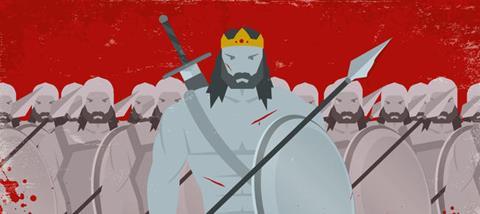We often think of David as the plucky young boy who defeated Goliath. In reality, he was a nation-builder as well as a mass murderer who ignored the rape of his own daughter.

I’m offended by the recent downgrading of King David in Bible history books. Many scholars now regard him in the same way as they usually view King Arthur ? a character with a colourful story but without any historical foundation. Perhaps because I share his name I’m taking this too personally, but I also feel that the intransigence of some historians in the light of new evidence about David’s life gives scholarship a bad name. It is true that he wasn’t the kind of hero we would want our children to emulate, but the evidence is piling up that he was a nation-builder of historic importance.
Historians constantly have to revise their thinking. For example, the Iron Age hill forts in England used to be regarded as refuges for surrounding farmers when they were attacked. But what enemy approached so slowly and publicly that farmers would have time to herd their animals and families to safety? Some archaeologists are now concluding that the hill forts were occupied by thugs running a protection racket ? putting the surrounding farmers under duress to bring them produce or be at risk of being forcibly taken.
At about the same time in Israel, David was operating in a similar way. Although we don’t normally tell his story this way, the Bible is very honest about it. When he was on the run from King Saul, who periodically tried to kill him, he gathered a band of other renegades and ‘protected’ the local herdsmen near his hideout. There was nothing romantic about this ? he didn’t give to the poor like Robin Hood, and he was liable to massacre farmers who didn’t show their gratitude (see 1 Samuel 25:34).
ADULTERY AND MURDER
The Bible stories about David are remarkably candid. They imply many unpleasant facts about him and sometimes plainly state his wrongdoings. We all know about Bathsheba, who was made famous by artists welcoming the excuse to paint a religious nude, and who is now preached about as a warning against pornography. Bored while everyone else was away on campaigns, David peered at houses from his roof. Bathsheba couldn’t be seen from any of the other walled rooftops, but the palace was much taller. Looking down from there was like peeping round New York with a telescope. Time has dissipated the horror and the sordidness of the story; what resulted from David’s voyeurism was adultery and murder.
It is amazing that this story and others weren’t hushed up better, because it was Bathsheba’s son Solomon who succeeded to the throne, and his ancestors continued to rule. Few governments allow such negative press about their rulers and their ancestors ? it is the opposite of any history they would wish to invent.
David’s record is full of faults and disastrous mistakes. In order to get food and equipment while on the run, he told the priest Ahimelek that he was on the king’s errand (1 Samuel 21:1?6). As a result of this lie, Saul executed the whole community of priests and their families for treason (1 Samuel 22:9?19). In exile among the Philistines, David massacred the populations of villages that he raided, so that no survivor could identify him (1 Samuel 27:11). And when he gained control of the country, he lost control of his children. His son Amnon raped his half-sister, Tamar, but David did nothing, so Absalom (Tamar’s brother) killed Amnon. David’s continued inaction prompted Absalom to organise a coup against his father that resulted in a period of civil war.
COURAGE AND FAITH
Perhaps it’s because of his precocious victory over the giant Goliath that we can forgive David for all of this. The story usually told to inspire our children is a Christian version of Jack and the Beanstalk. In both, the bit that children love best is cutting offthe giant’s head. What adults love best is the image of a small boy who trusts God.
But the Bible tells the story rather differently because the text implies that David was fully grown. The word Saul used for David ? ‘young man’ ? is the same word he used in describing Goliath as ‘a warrior since he was a young man’ (1 Samuel 17:33). We often hear that Saul’s armour was too big for David, but the text says the reason David rejected it was because he was inexperienced with it, not that he was too small for it (v39). David was already very strong ? he had brought provisions with him weighing more than 50 pounds (vs17-18) ? and he was able to swing Goliath’s own sword to cut off his head (v51). Ifthe iron head of Goliath’s javelin weighed 15 pounds (v7), the much larger sword would have been heavier than a sack of potatoes. Medieval swords seen in museums and movies are much lighter, but even they are too heavy for modern muscle-bound actors who regularly use titanium lookalikes.
However, we mustn’t minimise David’s courage or faith. Goliath is described as nine feet tall (v4) and his weaponry suggests he was beefy too ? though he wasn’t as gigantic as most artists paint him or children imagine him. And David’s only weapon was the slingshot he used for warding off wild animals. I’ve watched shepherds outside modern Nazareth aiming stones with amazing accuracy, so I find his defeat of Goliath quite believable. Yet his faith is still extraordinary.
NEW EVIDENCE
The detailed cycle of stories about David in the Bible contain too many negative aspects of his life to dismiss them as propaganda or as glorious inventions in a founding myth. These accounts present one of the most complex and complete characters in ancient history and are compellingly believable.
What resulted from David's voyeurism was adultery and murder
Nevertheless, some scholars removed David from history, and they did this for a very good reason: there was almost no external evidence for him in contemporary documents or archaeology. To try to explain this, they constructed sophisticated accounts of how these stories could have arisen during the Exile. However, in the 1990s, new archaeological evidence turned up. This included three occurrences of the actual name ‘David’: in an Egyptian hieroglyph, on an archway in Dan, and in a recovered portion of the Moabite stone (see details here). What I find surprising, and disappointing, is that instead of revising their accounts, some historians went into denial about these new facts, even dismissing them as forgery.
However, I can’t point the finger with much conviction. This is partly because this isn’t my area of expertise, so perhaps there are factors I’m not familiar with, but it’s also because I’m prone to do the same thing. If I like a theory or interpretation, I don’tusually appreciate facts which dispute it. Part of me, for example, would much rather ignore the Bible accounts and keep believing that David was a cute child who defeated a giant and a wise leader of his family and nation. But the biblical picture is clear: David was a tyrant.





































